
The Passion Week begins with the anointing of Yahushua by Mary Magdalene, an appropriate place to start since Mary will be our star witness in documenting the details of the burial and resurrection.
All four gospels contain a story of a woman anointing Yahushua:
Are these two different events?
The confusion occurs in Luke’s account, where it appears way back in chapter 7, giving the impression that it happened earlier in his ministry, and was not connected with the other stories. Since Luke’s account is intended to be chronological (“in order”), Luke 1:3, how should we understand this?
It must be the same event, because Yahushua said “wherever this gospel is preached … what she has done will also be told in memory of her” (Matthew 26:13, Mark 14:9). So there are four gospels, and each must fulfil the words of Yahushua and tell that story. Luke apparently places the story in chapter 7 because his theme in Luke 7:33-35 was that the Pharisees accused Yahushua of associating with “sinners”, and so he then amplifies the theme with a illustration of this “sinful woman” (Luke 7:39), which, although happening months later, fits his point.
We’ve already looked at the evidence showing that this is the same event recorded by all the gospels.Now John tells us in John 12:1 that this was “Six days before the Passover”.
John 12:12 tells us that Yahushua rode into Jerusalem on a donkey on the “next day”. This is the Triumphal Entry, and is recorded by all four gospel writers:
The multitudes are in Jerusalem for the Passover which will be in five days. Normally, the high priest would lead a lamb from Bethlehem into the city, and the lamb would be publicly inspected for four days. But this day, the true Lamb enters the city. The crowds wave palm branches and welcome Yahushua as he rides in. It is the end of the 62nd week since his baptism.
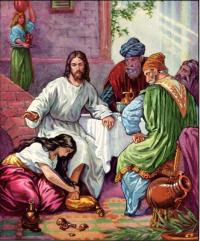 Was Yahushua anointed by a woman twice?
Was Yahushua anointed by a woman twice?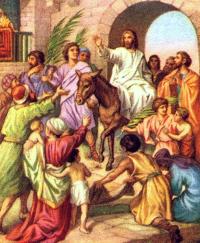
During the days immediately preceding the Passover, it is the time for the removal of leaven, a symbol of sin. During this time, all the extra leaven (except that which will be immediately consumed) is removed from the houses. Yahushua begins the work of removing leaven by once more cleansing the temple of the moneychangers.
It is also during these days that the disciples rent out the “Upper Room”, Matthew 26:17, Mark 14:12, and Luke 22:7.
The Pharisees, Sadducees, Herodians, etc., lose no time in their inspection of “The Lamb”. He’s in the Temple area in Jerusalem at the beginning of a pilgrimage feast, and he has recently entered the city as the prophesied King. He is the center of attention. Many of the well-known stories or sayings of Yahushua take place during these four days. Some of these are show in order below:
Paying tribute to Caesar
The lawyer and the greatest commandment
Whose son is the “Son of David”?
The widow’s mite
Some Greeks come up to Jerusalem for the Passover, and after talking with Philip, arrange an interview with Yahushua, John 12:20-22. At his birth, wise men from the East had come while the Jewish leadership rejected him; now, right before his death, wise men from the West come.
The 70 weeks had begun with the announcement from heaven, “This is my Beloved Son”, at the beginning of the Gospels:
Now, as he speaks with the Greeks (Gentiles) in the presence of the Jewish leaders, a voice from heaven once again speaks, John 12:28-30. The Jewish leaders confirm their rejection on the Messiah, John 12:37-50. It is now “after 62 weeks.”
When he had ejected the moneychangers (the second time) at the beginning of the week, he had called the Temple “my house”.
But now, right before the midst of the week, Yahushua proclaims “Behold, your house is left unto you desolate”, Matthew 23:38. “You will not see me again, until you say”, he declares, quoting Psalm 118:26, “Blessed is he who comes in the name of YHWH”, Matthew 23:39. (Note: Matthew 23:37-24:1 is parallel to Luke 13:34-35.) He has recently quoted that psalm before, specifically verse 22, “The stone which the builders rejected has become the cornerstone”, in:
He has nothing more to say to them, and walks out of the Temple, never to return. The “Year of Favor of YHWH” has ended. His disciples, remembering his statement of the previous year, “destroy this Temple and in three days I will raise it up” (John 2:19), assume it refers to Herod’s Temple, and call his attention to the massive stonework and impressive architecture:
This begins Yahushua’s discourse on the destruction of the Temple, and the signs of his return.
Now it’s Aviv 13, AD 28, one day before the Passover. The Passover will be in the midst of the 63rdweek, when “Messiah will be cut off, but not for himself”. (The Hebrew word used for "week" in the prophecy of Daniel 9 simply indicates a continuous count of a group of seven – it does not necessarily have to start at the first day of the week.)
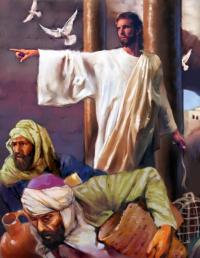

In the context of renting the “upper room” chronicled in the Synoptic Gospels, the [Feast of] Unleavened Bread is mentioned, Matthew 26:17, Mark 14:12, and Luke 22:7. However, the actual Feast of Unleavened Bread is an annual Sabbath which follows the Passover – what the Gospel writers are referring to are the days for the inspection of the Lamb and removal of leaven.
If you look in any detailed Bible Commentary, you will see that no matter what chronology you favor, there is an apparent contradiction between the Synoptic Gospels and John regarding the timing of the Last Supper in respect to Passover. Various explanations and workarounds are proposed.
For example, see pages 532-537 of Vol 5 of the 1980 SDA Bible Commentary entitled "Additional notes on Chapter 26 Note 1" for a detailed analysis. (Note: they use the Good Friday – Easter Sunday model, but the principle is the same.)
The best approach is to go with the Gospel of John, which contains three crucial details which help us to fit the other accounts. John also gives a more detailed version of this event than the other Gospels, which are a summary. The opinion of this presentation is that the Last Supper was a rehearsal for the Passover, which was the next day, and that Yahushua died at the exact time the Passover lamb was to be slain.
John 13:1-5
Now before the feast of the passover, when Jesus knew that his hour was come that he should depart out of this world unto the Father, having loved his own which were in the world, he loved them unto the end. 13:2 And supper being ended, the devil having now put into the heart of Judas Iscariot, Simon's son, to betray him; 13:3 Jesus knowing that the Father had given all things into his hands, and that he was come from God, and went to God; 13:4 He riseth from supper, and laid aside his garments; and took a towel, and girded himself. 13:5 After that he poureth water into a basin, and began to wash the disciples' feet, and to wipe them with the towel wherewith he was girded.
The washing of the feet occurred:
The supper was therefore not the Passover. Let us resume reading John 13. In the next few verses, John 13:6-21, Peter protests washing his feet, and Yahushua speaks of his betrayal. He continues with the theme of the betrayal.
John 13:21-29
When Jesus had thus said, he was troubled in spirit, and testified, and said, Verily, verily, I say unto you, that one of you shall betray me. 22 Then the disciples looked one on another, doubting of whom he spake. 23 Now there was leaning on Jesus' bosom one of his disciples, whom Jesus loved. 24 Simon Peter therefore beckoned to him, that he should ask who it should be of whom he spake. 25 He then lying on Jesus' breast saith unto him, Lord, who is it? 26 Jesus answered, He it is, to whom I shall give a sop, when I have dipped it. And when he had dipped the sop, he gave it to Judas Iscariot, the son of Simon. 27 And after the sop Satan entered into him. Then said Jesus unto him, That thou doest, do quickly. 28 Now no man at the table knew for what intent he spake this unto him. 29 For some of them thought, because Judas had the bag, that Jesus had said unto him, Buy those things that we have need of against the feast; or, that he should give something to the poor.
So after the foot washing, which is after the supper, Yahushua tells Judas to do something quickly, and the disciples think he is telling him to buy something needed for the Feast. The disciples know that the Passover has not yet occurred. Yahushua tells the betrayer to leave quickly because he wants to remove the “leaven” in preparation of the Passover, which has not yet occurred. You will notice that Judas leaves carrying the last piece of bread from the dish. In the Greek, the word “artos” is used – this is leavened bread. Judas removes the literal and symbolic leaven.
In the next verses, 31-35, Yahushua talks about his glorification, and the command to love each other as he has loved them. Then we read:
John 13:36-38
Simon Peter said unto him, Lord, whither goest thou? Jesus answered him, Whither I go, thou canst not follow me now; but thou shalt follow me afterwards. 37 Peter said unto him, Lord, why cannot I follow thee now? I will lay down my life for thy sake. 38 Jesus answered him, Wilt thou lay down thy life for my sake? Verily, verily, I say unto thee, The cock shall not crow, till thou hast denied me thrice.
So the order is:
Can we correlate this sequence in the Synoptic Gospels? After all, the other gospels do not mention the foot washing – or do they?
Luke 22:20-27
Likewise also the cup after supper, saying, This cup is the new testament in my blood, which is shed for you. 21 But, behold, the hand of him that betrayeth me is with me on the table. 22 And truly the Son of man goeth, as it was determined: but woe unto that man by whom he is betrayed! 23 And they began to inquire among themselves, which of them it was that should do this thing. 24 And there was also a strife among them, which of them should be accounted the greatest. 25 And he said unto them, The kings of the Gentiles exercise lordship over them; and they that exercise authority upon them are called benefactors. 26 But ye shall not be so: but he that is greatest among you, let him be as the younger; and he that is chief, as he that doth serve. 27 For whether is greater, he that sitteth at meat, or he that serveth? is not he that sitteth at meat? but I am among you as he that serveth.
This last verse is a reference to the foot washing Of course, some of these things are happening simultaneously – Yahushua is talking as he is washing the feet of each of the twelve apostles, and this is taking some time to complete.
In Luke 28-32, Yahushua tells of the Kingdom, and then starts to talk to Peter. As in John's account, the next thing which occurs is Peter's boast.
Luke 22:33-34
And he said unto him, Lord, I am ready to go with thee, both into prison, and to death. 22:34 And he said, I tell thee, Peter, the cock shall not crow this day, before that thou shalt thrice deny that thou knowest me.
Notice that Luke mentions the cup of the new testament, not mentioned by John, and places it after the supper, but before the foot washing and before Judas left. Again, we know that when Judas left, the disciples thought he was going to buy something for the Feast. Notice there is no mention about them eating the lamb. This is because the Last Supper is not the Passover.
We have correlated Luke with John. So here's the sequence so far
The final detail from John showing that the Last Supper was the day before the Passover is shown during the trail with Pilate:
John 18:27
Peter then denied again: and immediately the cock crew. 28 Then led they Jesus from Caiaphas unto the hall of judgment: and it was early; and they themselves went not into the judgment hall, lest they should be defiled; but that they might eat the passover. 29 Pilate then went out unto them, and said, What accusation bring ye against this man?
John shows that Pharisees knew that the Passover had not yet occurred. That is why they did not want to enter Pilate's hall - they didn't want to be defiled and prevented from keeping the Passover later that day.
There are a few minor points of discrepancy discussed in the Appendix. However, we have seen that the Last Supper is the day before the Passover, not the Passover itself.

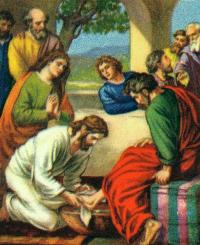
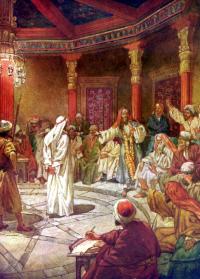
Both Herod and Pilate are in Jerusalem because of the political situation connected with the multitudes present for the Passover. Jerusalem at the time of Yahushua is not very large - the Temple Mount itself comprises about 15% of the city. The distance between Herod's Palace, Pilate's Judgment Hall, and the House of Caiaphas is less than half a mile, and the Crucifixion site and tomb are right outside the city gate. It does not take too long to travel between these points, especially with the assistance of the Roman army.
The leaders want to get the trial over as soon as possible – they certainly don't want to be interrupted by Nicodemus or Joseph of Arimethea coming to defend Yahushua. They expect that Pilate will quickly comply with their request. The times below are approximate, of course, and are shown in Roman time, but are given for the benefit of those who claim that the trials took several days, which is not the case.
12:00 am - Yahushua arrested in the Garden
Matthew 26:45-57, Mark 14:43-50, Luke 22:47-53, John 18:2-13
1:00 am – Trial before Annas
John 18:13:24
2:00 am – Night Trial before Caiaphas and the Sanhedrin
Matthew 26:57-75, Mark 14:53-72, Luke 22:54-65
5:00 am - Morning Trial before the priests and elders
Matthew 27:1, Mark 15:1, Luke 22:66-71
6:00 am – First Trial before Pilate
Matthew 27:2, Matthew 27:11-14, Mark 15:2-5, Luke 23:1-15, John 18:28-38
7:00 am – Appearance before Herod
Luke 23:6-12
8:00 am – Second Trial before Pilate
Matthew 27:15:31, Mark 15:6-19, Luke 23:13-25, John 18:39-19:16
9:00 am – Crucifixion
Matthew 27:31-44, Mark 15:20-32, Luke 23:26-43, John 19:17-37
3:00 pm – Darkness and Death
Matthew 27:45-51, Mark 15:33-39, Luke 23:44-49, John 19:17-37


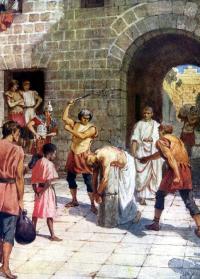

Yahushua dies. It's the "midst of the week", and the need for sacrifices has ceased. The veil in the Temple is ripped in two (Matthew 27:51, Mark 15:38). There is an earthquake, which opens the tombs of many of the saints. This is the marking of the wave sheaf. The dead saints are still dead, but the tombs are opened.
Joseph of Arimethea goes to Pilate, requests for the body of Yahushua; Pilate calls for the centurion and verifies the death.
Joseph wraps body, places it in the tomb, rolls stone, and departs. Mary Magdalene and the other women watch. Where is Joseph going? The women don't know. They leave.
Joseph had gone to get Nicodemus, who had been buying spices at the time he was meeting with Pilate. John had been escorting Yahushua's
mother Mary home accordance with the command of Yahushua in John 19:26-27. So John did not
see Joseph the first time, when the women watched him, as reported in the Synoptic Gospels.
When John returns, both Joseph and Nicodemus are there, but not the women. Therefore, John's gospel doesn't mention the women at the time
when both Joseph and Nicodemus came to the tomb. This is because they had left. Now, John's gospel is the only one which mentions
Nicodemus, John 19:38-42.
John 19:39-40
And there came also Nicodemus … and brought a mixture of myrrh and aloes, about an hundred pound weight. 40 Then took they the body of Jesus, and wound it in linen clothes with the spices, as the manner of the Jews is to bury.
So the sequence is:
This was the preparation day before the Sabbath, John 19:42. What kind of Sabbath was it? John has already told us a few verses earlier, in John 19:31.
The Jews therefore, because it was the preparation, that the bodies should not remain upon the cross on the sabbath day, (for that sabbath day was an high day,) besought Pilate that their legs might be broken, and that they might be taken away.
It was a “high Sabbath”. The 14th day of the first month is the Passover, which is itself a Preparation for the 15th day of the month, the Sabbath of Unleavened Bread. (The 15th is always a Sabbath according to the Lunar Calendar.) In this case, it is a “high Sabbath”, the Sabbath of Unleavened Bread.

There are two ways of reckoning the Seventh day Sabbath in use today. These are:
It is not the purpose of this website to prove or disprove either method of reckoning the Sabbath. The purpose of this website is to show that the ministry of Yahushua was 70 literal weeks, as opposed to 3 ½ years. The 70 week ministry is based on the feast days (ie, Passover), which are always reckoned by the Lunar Calendar. Also, in either case, the Resurrection was not on Sunday.
Using the Gregorian calendar, it can be shown that the Passover, and therefore the Crucifixion, was on "Wednesday", and that Resurrection
was not on "Sunday". This will fulfil the "3 days and 3 nights", and fit the "midst of the week", showing the validity of the 70 literal
week ministry. However, further research will reveal that the Hebrew calendar in us at the time of Yahushua did not correspond to the
Gregorian calendar. The rest of this document will use the Hebrew Lunar Calendar.
(Information on the Hebrew Calendar can be found here).
Luke 23:54-56
And that day was the preparation, and the sabbath drew on. 55 And the women also, which came with him from Galilee, followed after, and beheld the sepulchre, and how his body was laid. 56 And they returned, and prepared spices and ointments; and rested the sabbath day according to the commandment.
Now the priests go to Pilate on the High Sabbath day (violating its holiness) and request a guard. It is now the Feast of Unleavened Bread. Yahushua, the women, and the disciples are resting. The Roman guard watches the tomb, Matthew 27:66.
Matthew 27:62
Now the next day [High Sabbath of Unleavened Bread, the 15th], that followed the day of the preparation [Passover, the 14th], the chief priests and Pharisees came together unto Pilate …
The women want to give the body a proper burial because they left after Joseph rolled the stone and departed, as reported in the Synoptic Gospels. They did not see that Joseph returned with Nicodemus and prepared the body for burial, as reported by John. (Remember, John did not mention the women because they had already left.) So the women want to buy the spices and do the burial properly. They rest on the Sabbath, the 15th of the month, which is the Sabbath of Unleavened Bread, while Yahushua is still resting in the tomb.
Now let's look at the verses in Luke again, but with comments added.
Luke 23:54-56
And that day [Passover, the 14th] was the preparation, and the sabbath [High Sabbath of Unleavened Bread, the 15th] drew on. 55 And the women also, which came with him from Galilee, followed after, and beheld the sepulchre, and how his body was laid [not embalmed, because they didn't see Nicodemus come later]. 56 And they returned, and prepared spices and ointments [late on the 14th]; and rested the sabbath day [the 15th] according to the [fourth] commandment.
The women know that the tomb is guarded "until the third day" so they will wait for the guards' duty to expire before attempting to anoint the body.
Matthew 27:62-64
Now the next day, that followed the day of the preparation, the chief priests and Pharisees came together unto Pilate, Saying, Sir, we remember that that deceiver said, while he was yet alive, After three days I will rise again. Command therefore that the sepulchre be made sure until the third day,…
Even though the Sabbath, the 15th has passed, and it is now the 16th and the women can work, they can't access the guarded tomb. So the wait the entire day of the 16th, and then through the night. They will anoint the body on in the morning of the 17th, after the guard is finished. Notice that the concern of the women is not:
How shall we convince the guard let us in?
but
Mark 16:3 … Who shall roll us away the stone from the door of the sepulchre?
The women arrive around dawn, but before sunrise of the 17th. Unlike later traditions developed by the Rabbis, the Biblical day begins at sunrise, not sunset. If this concept is new to you, please see here for a detailed study with charts and over a dozen scripture references. Since the day begins at sunrise, the dawn which immediately precedes it is considered part of the previous calendar date.
Meanwhile, Mary Magdalene goes to the tomb alone. She plans to go in the the daylight with the other women and embalm the body, but now she is alone:
John 20:1
The first day of the week cometh Mary Magdalene early, when it was yet dark, unto the sepulchre, and seeth the stone taken away from the sepulchre.
So Mary gets there alone, and sees that the stone has been rolled away. Since there's always a full moon at Passover, she can see it from afar. She does not enter the sepulchre.
Continuing with John
John 20:2-10
Then she runneth, and cometh to Simon Peter, and to the other disciple, whom Jesus loved, and saith unto them, They have taken away the Lord out of the sepulchre, and we know not where they have laid him. 3 Peter therefore went forth, and that other disciple, and came to the sepulchre. 4 So they ran both together: and the other disciple did outrun Peter, and came first to the sepulchre. 5 And he stooping down, and looking in, saw the linen clothes lying; yet went he not in. 6 Then cometh Simon Peter following him, and went into the sepulchre, and seeth the linen clothes lie, 7 And the napkin, that was about his head, not lying with the linen clothes, but wrapped together in a place by itself. 8 Then went in also that other disciple, which came first to the sepulchre, and he saw, and believed. 9 For as yet they knew not the scripture, that he must rise again from the dead. 10 Then the disciples went away again unto their own home.
So it's still dark, right before dawn. Mary Magdalene runs to Peter and John, and tells them that the body is missing. Peter and John race to the tomb, look inside, and see the graveclothes. Mary has not seen this. The men head back home. Meanwhile, Mary is getting the other women. She is still intending to embalm the body with the other women in the daylight, except now she doesn't know where the body is.
Mark 16:1-3
And when the sabbath was past, Mary Magdalene, and Mary the mother of James, and Salome, had bought sweet spices, that they might come and anoint him. 2 And very early in the morning the first day of the week [according to the Hebrew calendar; see chart], they came unto the sepulchre at the rising of the sun. 3 And they said among themselves, Who shall roll us away the stone from the door of the sepulchre?
Mary Magdalene gets the other women, and they all head to the tomb, following their original plan. The other women discuss the issue of who will roll away the stone, but Mary knows that it's already been moved. It's very early on the first day of the Hebrew week, the 16th of the month. (It is not "Sunday". There's no such calendar day until Constantine introduces it 300 years later.) Mary has been awake all night, and probably longer than that. Anyway, she arrives at the tomb before the other women – she needs to find out what happened to the body. We know that she is concerned with finding the body because that's what she tells the angels, John 20:13.
Back to John
John 20:11-13
But Mary stood without at the sepulchre weeping: and as she wept, she stooped down, and looked into the sepulchre, 12 And seeth two angels in white sitting, the one at the head, and the other at the feet, where the body of Jesus had lain. 13 And they say unto her, Woman, why weepest thou? She saith unto them, Because they have taken away my Lord, and I know not where they have laid him.
She stands weeping outside the tomb. Finally, she looks in, and sees not only the graveclothes but two angels. She is still looking for the body.
And continuing with Mark, we see what happens when the other women arrive.
Mark 16:4-6
And when they looked, they saw that the stone was rolled away: for it was very great. 5 And entering into the sepulchre, they saw a young man sitting on the right side, clothed in a long white garment; and they were affrighted. 6 And he saith unto them, Be not affrighted: Ye seek Jesus of Nazareth, which was crucified: he is risen; he is not here: behold the place where they laid him.
Luke gives the similar details as Mark, but mentions two angels:
Luke 24:1-10
Now upon the first day of the week, very early in the morning, they came unto the sepulchre, bringing the spices which they had prepared, and certain others with them. 2 And they found the stone rolled away from the sepulchre. 3 And they entered in, and found not the body of the Lord Jesus. 4 And it came to pass, as they were much perplexed thereabout, behold, two men stood by them in shining garments: 5 And as they were afraid, and bowed down their faces to the earth, they said unto them, Why seek ye the living among the dead? 6 He is not here, but is risen: remember how he spake unto you when he was yet in Galilee, 7 Saying, The Son of man must be delivered into the hands of sinful men, and be crucified, and the third day rise again. 8 And they remembered his words, 9 And returned from the sepulchre, and told all these things unto the eleven, and to all the rest. 10 It was Mary Magdalene, and Joanna, and Mary the mother of James, and other women that were with them, which told these things unto the apostles.
The angels speak to the women, as reported in all 4 gospels:
The angel tells the women to go meet the disciples and to remind them to meet Yahushua in Galilee. This was arranged before, as recorded here:
Mary Magdalene hesitates in her departure. As she's turning, she sees someone she thinks is the gardener, and starts to ask him where the body is.
John continues:
John 20:14-16
And when she had thus said, she turned herself back, and saw Jesus standing, and knew not that it was Jesus. 15 Jesus saith unto her, Woman, why weepest thou? whom seekest thou? She, supposing him to be the gardener, saith unto him, Sir, if thou have borne him hence, tell me where thou hast laid him, and I will take him away. 16 Jesus saith unto her, Mary. She turned herself, and saith unto him, Rabboni; which is to say, Master.
She's so concerned about finding and anointing the body that she doesn't realize that she had anointed him the week before, and that the empty tomb indicates his resurrection!
Matthew 26:12-13
For in that she hath poured this ointment on my body, she did it for my burial. 13 Verily I say unto you, Wheresoever this gospel shall be preached in the whole world, there shall also this, that this woman hath done, be told for a memorial of her.
When Mary realizes that the “gardener” is really Yahushua, she grabs him, and the other women who were leaving to find the disciples, come back and hold him too. The three scriptures below all refer to this one event:
John 20:17
Jesus saith unto her, Touch me not; for I am not yet ascended to my Father: but go to my brethren, and say unto them, I ascend unto my Father, and your Father; and to my God, and your God.
Matthew 28:9
And as they went to tell his disciples, behold, Jesus met them, saying, All hail. And they came and held him by the feet, and worshipped him.
Mark 16:9
Now when Jesus was risen early the first day of the week, he appeared first to Mary Magdalene, out of whom he had cast seven devils.
Note that the "first day of the week" is according to the Hebrew Calendar.
Yahushua tells the women, especially Mary, not to hold him because he hasn't yet ascended to his Father, and to that they should continue to tell the disciples. It's the Feast of First fruits, and He is going to present the risen saints as a wave sheaf offering.
The rest of the story: the "Road to Emmaus", "Doubting Thomas", "The Ascension", etc, and the associated chronology is well known. But the seventy weeks has not ended. John the Baptist had said that Yahushua was going to baptize with the Holy Spirit and with fire, Matthew 3:11, Luke 3:16.
This study provides a time frame for the Passion Week which a harmonizes with the Gopsel accounts,and fits in the context of Daniel's seventy-week prophecy, and in particular a fulfillment of the event taking place “after sixty two weeks” in the “midst of the week”. While attempting to find a chronology of the Gospels, we have solved another problem – the issue of “three days and three nights”. In other words, if you have a seventy-week ministry starting in AD 27, you automatically get the proper chronology of the death and resurrection.
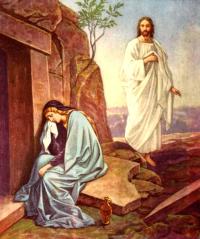

There is a solution that gives 3 actual days and 3 actual nights in the tomb, and agrees with all the Biblical details. It involves a proper understanding of a seemingly simple question: "When does a day begin?"
The Roman day starts and ends at midnight. The Rabbis and most Jews today count their days, especially the Sabbath, from evening to evening. Is this really what what the Bible teaches? Consider the following points, which can be proved by Scripture here.
The diagram below illustrates this concept.

 Does a day really begin at night?
Does a day really begin at night?
How do these new insights apply to the "3 days and 3 nights", and the Resurrection?
Mark 16:2
And very early in the morning the first day of the week, they came unto the sepulchre at the rising of the sun.
Luke 24:1
Now upon the first day of the week, very early in the morning, they came unto the sepulchre, bringing the spices which they had prepared, and certain others with them.
 Again, since the day does not begin until sunrise, the time described as "early in the morning, before sunrise" is actually about 23 hours
later than traditionally taught!
Again, since the day does not begin until sunrise, the time described as "early in the morning, before sunrise" is actually about 23 hours
later than traditionally taught!
When applied to the Resurrection, the Biblical reckoning is 24 hours later than the traditional interpretation! This provides the "3 days and 3 nights". And this is what it looks like:

The Baptism by Fire is the final event in his seventy week ministry, and it occurs on Pentecost, on the 9th day of the 3rd month, AD 28. (This follows the "count of seven Sabbaths complete", with the final Sabbath being on the 8th day of that month.)
So from Yahushua's baptism by water to baptism with fire consisted of 70 literal weeks – 490 days – no more, no less, from 21st day of the 11th month, AD 27 to 9th day of the 3rd month, AD 28.
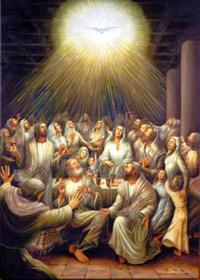 The 490 days ended with the Baptism by Fire at Pentecost.
The 490 days ended with the Baptism by Fire at Pentecost.

Q.Why didn't Joseph of Arimethea and Nicodemus work with the women in preparing the body for burial?
A. Because Joseph and Nicodemus were Pharisees and secret disciples and they did not know those women.
Q.Was Mary Magdalene at the Last Supper?
A.We can assume she was not present at the Last Supper, because no one wanted to wash the feet of the disciples. If Mary was there, she would likely have volunteered.
Q.Since Yahushua said:
doesn't that prove that “The Last Supper” is the Passover?
A.Not necessarily. Although he desired to eat the Passover with his disciples, he submitted to his Father's will that he should be the Passover instead. After the supper, he prayed.
Matthew 26:42 “O my Father, if this cup may not pass away from me, except I drink it, thy will be done.”
And at the time that the national Passover lamb was sacrificed he died. (Besides the lamb killed at the temple for the nation, note that there were many lambs killed on Passover for the individual families before.)
One needs to read Luke 22:15 in the light of the next verse, Luke 22:16 (KJV).
Luke 22:13
And they went, and found as he had said unto them: and they made ready the passover. 14 And when the hour was come, he sat down, and the twelve apostles with him. 15 And he said unto them, With desire I have desired to eat this passover with you before I suffer: 16 For I say unto you, I will not any more eat thereof, until it be fulfilled in the kingdom of God.
Note that the KJV says “eat any more thereof”. Most translations follow the KJV interpretation, saying something like “eat of it again”, but there are some which do not. Note this interpretation:
vs 15-16 "I have fervently desired to eat this Passover with you before I suffer, but I am telling you that I will not eat it until it is fulfilled in the kingdom of God."
Does this agree with the Greek? Yes. For a literal translation from the Greek, see Page 235 "The Interlinear Bible Vol IV 2nd Edition (c) 1985 Jay P. Green, Sr, ISBN 978-1-56563-979-9" . Please note that this Greek is the Textus Receptus on which the KJV is based.
"With desire I desired this passover to eat with you, before the me to suffer. I say For to you that never in any way I eat of it, until when it is fulfilled in the kingdom of God."
Just from a contextual point of view, I think this translation of the verse is better. With the standard interpretation, what is the point of him waiting until it be fulfilled in the kingdom of God if he just did it?
So to summarize: Yahushua had a desire to eat the Passover with his disciples, but he submitted to the will of his Father, and told his disciples he would not eat of it until it would be fulfilled in the future Kingdom. The reference in verse 13, "made ready the passover", does not prove that the Last Supper was the Passover – it only shows that they cleaned the house of leaven, and got the articles ready.
Q.Since the Pharisees said that they would not kill Yahushua on the Passover, then how could he have died on that day?
Matthew 26:4-5 And consulted that they might take Jesus by subtlety, and kill him. But they said, Not on the feast day, lest there be an uproar among the people.
Mark 14:2 But they said, Not on the feast day, lest there be an uproar of the people.
A.The Pharisees did not kill Yahushua on the Passover, or any other day for that matter. They tricked the Romans into killing him on Passover (by threatening Pilate to report him to Caesar, John 19:12). Since they got the Romans involved, they were no longer worried about being blamed for a riot. Also, they had originally tried at different times to stone him. But now using Rome, they could have him crucified, which would imply that Yahushua was cursed, being “hung on a tree.” (Deuteronomy 21:22, Galatians 3:13)
John 19:12 And from thenceforth Pilate sought to release him: but the Jews cried out, saying, If thou let this man go, thou art not Caesar's friend: whosoever maketh himself a king speaketh against Caesar.
Deuteronomy 21:23 His body shall not remain all night upon the tree, but thou shalt in any wise bury him that day; (for he that is hanged is accursed of God;) that thy land be not defiled, which the LORD thy God giveth thee for an inheritance.
Q.Does the conversation on the Road to Emmaus prove a Friday to Sunday chronology?
Luke 24:18 And the one of them, whose name was Cleopas, answering said unto him, Art thou only a stranger in Jerusalem, and hast not known the things which are come to pass there in these days? 19 And he said unto them, What things? And they said unto him, Concerning Jesus of Nazareth, which was a prophet mighty in deed and word before God and all the people: 20 And how the chief priests and our rulers delivered him to be condemned to death, and have crucified him. 21 But we trusted that it had been he which should have redeemed Israel: and beside all this, to day is the third day since these things were done. 22 Yea, and certain women also of our company made us astonished, which were early at the sepulchre; 23 And when they found not his body, they came, saying, that they had also seen a vision of angels, which said that he was alive. 24 And certain of them which were with us went to the sepulchre, and found it even so as the women had said: but him they saw not.
A.They say the third day “since these things were done”. When is it “done”? It can't be at the crucifixion itself, since Yahushua was yet to be buried. If it refers to a time after he was buried, and everyone went home for the Sabbath of Unleavened Bread because everything was “done”, and then “since” that time it is the third day, then there is no problem.
Q.Doesn't "inclusive reckoning" show that the "three days" can just include parts of "three days", for example, part of Friday, all of Saturday, and part of Sunday?
A.Yes, the Jewish usage can allow for that interpretation. However, when Yahushua specifically said "three days and three nights" (Matthew 12:40), he made it clear that is was actually three days and three nights. Even if a part is inclusive, it still has to be there. In the common "part of Friday, all of Saturday, and part of Sunday" interpretation, there are not three nights, or even parts of three nights. In 1 Corinthians, Paul references that the "third day" was according to the "scriptures". What "scriptures" did Yahushua and Paul mean?
1 Corinthians 15:3-4
For I delivered unto you first of all that which I also received, how that Christ died for our sins according to the scriptures; And that he was buried, and that he rose again the third day according to the scriptures
What did he mean by the "third day"? We need to look at the original scripture, which is in the book of Jonah:
Jonah 1:17
Now the LORD had prepared a great fish to swallow up Jonah. And Jonah was in the belly of the fish three days and three nights.
Matthew 12:39
But he answered and said unto them, An evil and adulterous generation seeketh after a sign; and there shall no sign be given to it, but the sign of the prophet Jonas For as Jonas was three days and three nights in the whale's belly; so shall the Son of man be three days and three nights in the heart of the earth.
It is quite possible that Jonah actually died in the belly of the beast (see verse 2:6), and was resurrected upon his expulsion onto the shore. At any rate, Yahushua promised the rulers a clear public sign.

In Matthew, the Last Supper sequence is described in Matthew 26:20-35. Matthew describes the question of Judas “Is it I?” before the presentation of the cup. He also mentions Peter's boast of loyalty after saying that they went to the Mount of Olives. In the account in Mark 14:17-31, Mark also mentions Peter's boast of loyalty after saying that they went to the Mount of Olives.
These things may have happened more than once, as part of ongoing discussion, or they may just be summarized.

Download this page, which is Part 2: The Chronology of the Crucifixion and Resurrection (200 KBytes)
Read Part 1: Harmony Of Gospels 70 Weeks